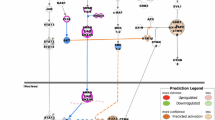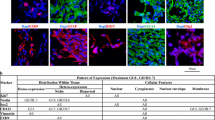Abstract
Mesenchymal stem cells (MSC) have been found in various cancers and were discussed to influence tumor biology. Cells fulfilling the complete MSC criteria, including surface marker expression (CD73, CD90, CD105) and tri-lineage differentiation, have been isolated solely from a low percentage of high-grade meningiomas. In contrast, pure co-expression of the surface-markers was relatively frequent, raising the question for an additional role of these membrane proteins in meningiomas. Therefore, here we analyzed the expression of CD73, CD90 and CD105 in a series of meningiomas of all grades. Although no significant association of any marker with meningeal tumor growth per se or with tumor-grade was observed, we detected a positive Pearson correlation (r = 0.55, p ≤ 0.05) in low-grade tumors between CD73 and the most relevant tumor suppressor NF2/Merlin, supported by a tendency of lower CD73 expression in cases with allelic losses at the NF2-locus, which express significantly lower NF2/Merlin-mRNA (p ≤ 0.05). In two pairs of syngenous meningeal or meningioma cell lines with or without shRNA-mediated knockdown of NF2/Merlin a nearly complete loss of CD73 mRNA expression was observed after the knockdown (p ≤ 0.001). This suggested that the correlation observed in tumors may result from a direct functional link between Merlin and CD73. Since CD73 is a 5′-exonucleotidase (termed NT5E), we discuss a potential role of NT5E-mediated purinergic signaling to modulate actin-cytoskeleton and cell contacts, which may be a functional link to NF2/Merlin.


Similar content being viewed by others
References
Mawrin C, Perry A (2010) Pathological classification and molecular genetics of meningiomas. J Neurooncol 99:379–391
Perry A, Scheithauer BW, Stafford SL, Lohse CM, Wollan PC (1999) “Malignancy” in meningiomas: a clinicopathologic study of 116 patients, with grading implications. Cancer 85:2046–2056
Mawrin C, Chung C, Preusser M (2015) Biology and clinical management challenges in meningioma. American Society of Clinical Oncology educational book/ASCO American Society of Clinical Oncology Meeting, pp e106–e115. https://doi.org/10.14694/EdBook_AM.2015.35.e106
Weber RG, Bostrom J, Wolter M, Baudis M, Collins VP, Reifenberger G, Lichter P (1997) Analysis of genomic alterations in benign, atypical, and anaplastic meningiomas: toward a genetic model of meningioma progression. Proc Natl Acad Sci USA 94:14719–14724
Ruttledge MH, Sarrazin J, Rangaratnam S, Phelan CM, Twist E, Merel P, Delattre O, Thomas G, Nordenskjold M, Collins VP et al (1994) Evidence for the complete inactivation of the NF2 gene in the majority of sporadic meningiomas. Nat Genet 6:180–184
Ruttledge MH, Xie YG, Han FY, Peyrard M, Collins VP, Nordenskjold M, Dumanski JP (1994) Deletions on chromosome 22 in sporadic meningioma. Genes Chromosom Cancer 10:122–130
Kalamarides M, Stemmer-Rachamimov AO, Niwa-Kawakita M, Chareyre F, Taranchon E, Han ZY, Martinelli C, Lusis EA, Hegedus B, Gutmann DH, Giovannini M (2011) Identification of a progenitor cell of origin capable of generating diverse meningioma histological subtypes. Oncogene 30:2333–2344
Rhee K-J, Lee JI, Eom YW (2015) Mesenchymal stem cell-mediated effects of tumor support or suppression. Int J Mol Sci 16:30015–30033. https://doi.org/10.3390/ijms161226215
Norozi F, Ahmadzadeh A, Shahrabi S, Vosoughi T, Saki N (2016) Mesenchymal stem cells as a double-edged sword in suppression or progression of solid tumor cells. Tumor Biol 37:11679–11689. https://doi.org/10.1007/s13277-016-5187-7
Karnoub AE, Dash AB, Vo AP, Sullivan A, Brooks MW, Bell GW, Richardson AL, Polyak K, Tubo R, Weinberg RA (2007) Mesenchymal stem cells within tumour stroma promote breast cancer metastasis. Nature 449:557–563. https://doi.org/10.1038/nature06188
Shinagawa K, Kitadai Y, Tanaka M, Sumida T, Kodama M, Higashi Y, Tanaka S, Yasui W, Chayama K (2010) Mesenchymal stem cells enhance growth and metastasis of colon cancer. Int J Cancer 127:2323–2333. https://doi.org/10.1002/ijc.25440
Tsukamoto S, Honoki K, Fujii H, Tohma Y, Kido A, Mori T, Tsujiuchi T, Tanaka Y (2012) Mesenchymal stem cells promote tumor engraftment and metastatic colonization in rat osteosarcoma model. Int J Oncol 40:163–169. https://doi.org/10.3892/ijo.2011.1220
Comsa S, Ciuculescu F, Raica M (2012) Mesenchymal stem cell-tumor cell cooperation in breast cancer vasculogenesis. Molecular medicine reports 5:1175–1180. https://doi.org/10.3892/mmr.2012.796
Weber CE, Kothari AN, Wai PY, Li NY, Driver J, Zapf MA, Franzen CA, Gupta GN, Osipo C, Zlobin A, Syn WK, Zhang J, Kuo PC, Mi Z (2015) Osteopontin mediates an MZF1-TGF-beta1-dependent transformation of mesenchymal stem cells into cancer-associated fibroblasts in breast cancer. Oncogene 34:4821–4833. https://doi.org/10.1038/onc.2014.410
Coffman LG, Choi YJ, McLean K, Allen BL, di Magliano MP, Buckanovich RJ (2016) Human carcinoma-associated mesenchymal stem cells promote ovarian cancer chemotherapy resistance via a BMP4/HH signaling loop. Oncotarget 7:6916–6932. https://doi.org/10.18632/oncotarget.6870
Hu D, Wang X, Mao Y, Zhou L (2012) Identification of CD105 (endoglin)-positive stem-like cells in rhabdoid meningioma. J Neurooncol 106:505–517
Lim HY, Kim KM, Kim BK, Shim JK, Lee JH, Huh YM, Kim SH, Kim EH, Park EK, Shim KW, Chang JH, Kim DS, Kim SH, Hong YK, Lee SJ, Kang SG (2013) Isolation of mesenchymal stem-like cells in meningioma specimens. Int J Oncol 43:1260–1268. https://doi.org/10.3892/ijo.2013.2053
Duff SE, Li C, Garland JM, Kumar S (2003) CD105 is important for angiogenesis: evidence and potential applications. FASEB J 17:984–992. https://doi.org/10.1096/fj.02-0634rev
Dallas NA, Samuel S, Xia L, Fan F, Gray MJ, Lim SJ, Ellis LM (2008) Endoglin (CD105): a marker of tumor vasculature and potential target for therapy. Clin Cancer Res 14:1931–1937. https://doi.org/10.1158/1078-0432.ccr-07-4478
Barresi V, Cerasoli S, Vitarelli E, Tuccari G (2007) Density of microvessels positive for CD105 (endoglin) is related to prognosis in meningiomas. Acta Neuropathol 114:147–156. https://doi.org/10.1007/s00401-007-0251-4
Barresi V, Cerasoli S, Tuccari G (2008) Correlative evidence that tumor cell-derived caveolin-1 mediates angiogenesis in meningiomas. Neuropathology 28:472–478. https://doi.org/10.1111/j.1440-1789.2008.00902.x
Barresi V, Alafaci C, Salpietro F, Tuccari G (2008) Sstr2A immunohistochemical expression in human meningiomas: is there a correlation with the histological grade, proliferation or microvessel density? Oncol Rep 20:485–492
Ling C, Pouget C, Rech F, Pflaum R, Treffel M, Bielle F, Mokhtari K, Casse JM, Vignaud JM, Kalamarides M, Peyre M, Gauchotte G (2016) Endothelial cell hypertrophy and microvascular proliferation in meningiomas are correlated with higher histological grade and shorter progression-free survival. J Neuropathol Exp Neurol 75:1160–1170. https://doi.org/10.1093/jnen/nlw095
Inoue A, Tanaka J, Takahashi H, Kohno S, Ohue S, Umakoshi A, Gotoh K, Ohnishi T (2016) Blood vessels expressing CD90 in human and rat brain tumors. Neuropathology 36:168–180. https://doi.org/10.1111/neup.12244
Di Virgilio F, Adinolfi E (2017) Extracellular purines, purinergic receptors and tumor growth. Oncogene 36:293–303. https://doi.org/10.1038/onc.2016.206
Mawrin C, Wolke C, Haase D, Kruger S, Firsching R, Keilhoff G, Paulus W, Gutmann DH, Lal A, Lendeckel U (2010) Reduced activity of cd13/aminopeptidase n (APN) in aggressive meningiomas is associated with increased levels of SPARC. Brain Pathol 20:200–210
Pachow D, Andrae N, Kliese N, Angenstein F, Stork O, Wilisch-Neumann A, Kirches E, Mawrin C (2013) mTORC1 inhibitors suppress meningioma growth in mouse models. Clin Cancer Res 19:1180–1189
Puttmann S, Senner V, Braune S, Hillmann B, Exeler R, Rickert CH, Paulus W (2005) Establishment of a benign meningioma cell line by hTERT-mediated immortalization. Lab Invest 85:1163–1171
Striedinger K, Vandenberg SR, Baia GS, McDermott MW, Gutmann DH, Lal A (2008) The neurofibromatosis 2 tumor suppressor gene product, merlin, regulates human meningioma cell growth by signaling through YAP. Neoplasia 10:1204–1212
Amin ND, Bai G, Klug JR, Bonanomi D, Pankratz MT, Gifford WD, Hinckley CA, Sternfeld MJ, Driscoll SP, Dominguez B, Lee K-F, Jin X, Pfaff SL (2015) Loss of motoneuron-specific microRNA-218 causes systemic neuromuscular failure. Science 350:1525–1529. https://doi.org/10.1126/science.aad2509
Allard B, Beavis PA, Darcy PK, Stagg J (2016) Immunosuppressive activities of adenosine in cancer. Curr Opin Pharmacol 29:7–16. https://doi.org/10.1016/j.coph.2016.04.001
Young A, Ngiow SF, Barkauskas DS, Sult E, Hay C, Blake SJ, Huang Q, Liu J, Takeda K, Teng MW, Sachsenmeier K, Smyth MJ (2016) Co-inhibition of CD73 and A2AR adenosine signaling improves anti-tumor immune responses. Cancer Cell 30:391–403. https://doi.org/10.1016/j.ccell.2016.06.025
Wang L, Tang S, Wang Y, Xu S, Yu J, Zhi X, Ou Z, Yang J, Zhou P, Shao Z (2013) Ecto-5′-nucleotidase (CD73) promotes tumor angiogenesis. Clin Exp Metastas 30:671–680. https://doi.org/10.1007/s10585-013-9571-z
Turcotte M, Spring K, Pommey S, Chouinard G, Cousineau I, George J, Chen GM, Gendoo DM, Haibe-Kains B, Karn T, Rahimi K, Le Page C, Provencher D, Mes-Masson AM, Stagg J (2015) CD73 is associated with poor prognosis in high-grade serous ovarian cancer. Cancer Res 75:4494–4503. https://doi.org/10.1158/0008-5472.can-14-3569
Loi S, Pommey S, Haibe-Kains B, Beavis PA, Darcy PK, Smyth MJ, Stagg J (2013) CD73 promotes anthracycline resistance and poor prognosis in triple negative breast cancer. Proc Natl Acad Sci USA 110:11091–11096. https://doi.org/10.1073/pnas.1222251110
Ren ZH, Lin CZ, Cao W, Yang R, Lu W, Liu ZQ, Chen YM, Yang X, Tian Z, Wang LZ, Li J, Wang X, Chen WT, Ji T, Zhang CP (2016) CD73 is associated with poor prognosis in HNSCC. Oncotarget 7:61690–61702. https://doi.org/10.18632/oncotarget.11435
James MF, Manchanda N, Gonzalez-Agosti C, Hartwig JH, Ramesh V (2001) The neurofibromatosis 2 protein product merlin selectively binds F-actin but not G-actin, and stabilizes the filaments through a lateral association. Biochem J 356:377–386
James MF, Lelke JM, Maccollin M, Plotkin SR, Stemmer-Rachamimov AO, Ramesh V, Gusella JF (2008) Modeling NF2 with human arachnoidal and meningioma cell culture systems: NF2 silencing reflects the benign character of tumor growth. Neurobiol Dis 29:278–292. https://doi.org/10.1016/j.nbd.2007.09.002
Stamenkovic I, Yu Q (2010) Merlin, a “magic” linker between the extracellular cues and intracellular signaling pathways that regulate cell motility, proliferation, and survival. Curr Protein Pept Sci 11:471–484
Gao ZW, Dong K, Zhang HZ (2014) The roles of CD73 in cancer. BioMed Res Int 2014:460654. https://doi.org/10.1155/2014/460654
Bowser JL, Blackburn MR, Shipley GL, Molina JG, Dunner K Jr, Broaddus RR (2016) Loss of CD73-mediated actin polymerization promotes endometrial tumor progression. J Clin Invest 126:220–238. https://doi.org/10.1172/jci79380
Acknowledgements
The technical assistance of Sandra Hartmann and Leona Bueck is highly appreciated.
Funding
This study was funded partly by grants from the DFG (Grant # MA2530/6-1 and MA2530/8-1), the Wilhelm Sander-Stiftung (Grant #2014.092.1), and the Deutsche Krebshilfe (Grant #111853) (all to C.M.).
Author information
Authors and Affiliations
Corresponding author
Ethics declarations
Conflict of interest
The authors declared that they have no conflict of interest.
Ethical approval
This article does not contain any studies with human participants performed by any of the authors.
Electronic supplementary material
Below is the link to the electronic supplementary material.
Rights and permissions
About this article
Cite this article
Kirches, E., Steffen, T., Waldt, N. et al. The expression of the MSC-marker CD73 and of NF2/Merlin are correlated in meningiomas. J Neurooncol 138, 251–259 (2018). https://doi.org/10.1007/s11060-018-2807-7
Received:
Accepted:
Published:
Issue Date:
DOI: https://doi.org/10.1007/s11060-018-2807-7




